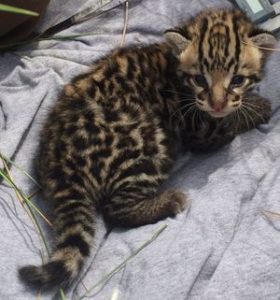Where there are kittens, there’s hope.
Four of the seven known female ocelots at Laguna Atascosa National Wildlife Refuge have been photographed with new kittens, including one discovered in the first ocelot den found on the refuge in 20 years.
Of the seven known adult females, two are just reaching the age to reproduce, three have been photographed with healthy-looking kittens, one was tracked to the den with a kitten and one adult female has not been seen with any offspring.
The past two years have not been kind to the endangered Texas ocelot subspecies. Between June 2015 and April of this year, seven ocelots — six males and a female — are known to have died after being hit by vehicles. In all, Texas ocelots number about 80, with around 15 of them at Laguna Atascosa.
So the kittens are very good news for the local ocelot population.
“I suspect that the past couple of years of abundant rainfall have made excellent breeding conditions for these endangered wild cats,” said Hilary Swarts, wildlife biologist with the U.S. Fish and Wildlife Service who is stationed at Laguna Atascosa.
Swarts said such conditions lead to abundant plant growth which provides more food for prey species like rodents, rabbits and birds.
“With plenty of food and water, and minimal disturbance from humans, female ocelots have all the resources they need to reproduce successfully,” Swarts added.
Using GPS, biologists tracked one of the female ocelots and she led the team to the den.
Once there, researchers found the tiny kitten which weighed just under a pound and was probably just three weeks old.
The biologists took measurements and photos and left the area quickly to minimize disturbance to the den. The kitten’s mother, approximately 11 years old, was not at the den at the time but returned soon after. Researchers plan to track the kitten’s growth and progress.
Researchers also found that of the adult females captured on camera at the Yturria Conservation Easement in Willacy County, at least three have had kittens this past year. Ocelot females usually have only one kitten per litter, but researchers found one of the three cats had twins.
“Data gathered in Willacy County is further evidence that private ranches are often great havens for wildlife and key partners in our conservation efforts,” said Boyd Blihovde, refuge manager at Laguna Atascosa. “These private lands will be crucial to protecting habitat and wildlife into the future.”
While biologists are sure Laguna Atascosa has around 15 ocelots at any one time, numbers in the rest of the cats’ range in Cameron, Willacy and Kenedy counties are murky. Many landowners have declined requests to allow federal biologists access to their property.





